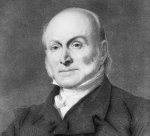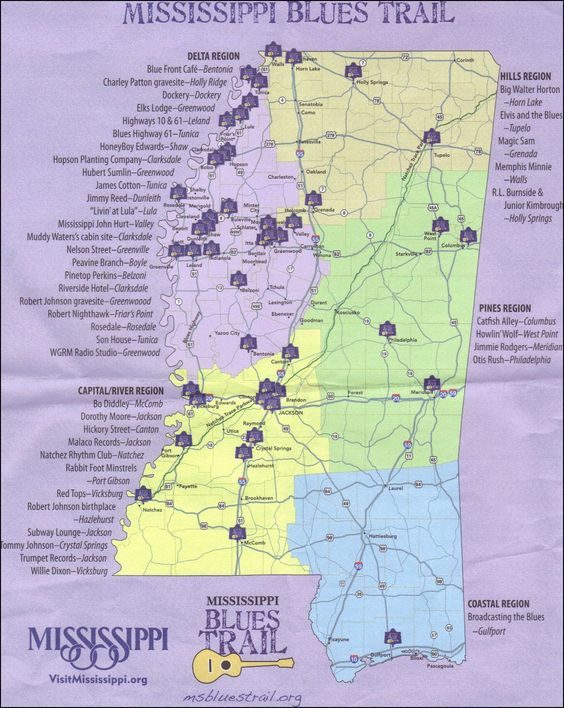[NOTE: Anyone who has perused the “Blues Stories” page of this blog will know that, of all the stopping places available to fans interested in “Blues Geography,” my favorite location is the Mississippi Delta, generally regarded as the “birthplace of the Blues.” Thing is, though, even to me, a Blues aficionado for more than twenty-five years, the Blues sometimes seems to be on its last legs. In fact, with the recent demise of B.B. King, some Blues scholars believe we have entered the “classical music” phase of the Blues–all the “true originals” have died, and those who remain either merely “cover” classic Blues tunes or, in their own work, whatever their talents, really don’t measure up to the “greats.”
And yet: the Delta is still there, so perhaps there’s hope for yet another “Blues revival,” this one to carry that music well into the twenty-first century. What follows is an account of a trip we took, following the Delta segment of the “Mississippi Blues Trail,” in May 2013, a trek that was mostly about the Blues of the past, not the Blues of the present (but then, I’m a historian).
Note: Except for the maps in this segment and the photos of the Ground Zero Blues Club and the Abbay and Leatherman marker on the Blues Trail in Part 2, the photography was done by my Willowy Bride (referred to hereafter as “the WB.”]
* * * * *
May 22, 2013
This morning around 8:00 a.m., we left Pearl, Mississippi, where we’d stopped yesterday to see a Mississippi Braves game, for a leisurely drive up “Highway 49.” This route, along with its western neighbor, “Highway 61,” helped shuttle thousands of African Americans, including not a few Blues performers, out of the Mississippi Delta and into the “Promised Land” of Chicago and other cities to the east and west. I had mapped out an itinerary that would take us up route 49 to Indianola, then across on 82 to pick up route 61 at Leland.
On the way to Indianola, we turned off 49 for a quick look at Belzoni, which advertises itself as the “Catfish Capital of the World.” (Though, to a Blues fan, Belzoni will always be the place Charlie Patton spent time in jail, thanks to the local sheriff.) The town even hosts each April a Catfish Festival that reportedly draws about 10,000 visitors.
Perhaps the combined Catfish Museum and Welcome Center had been overtaxed by last month’s festival, for, when we arrived a half hour or so after the announced opening time, the building still was locked up tight. We were able to see a few artifacts on the grounds related to the raising of catfish, as well as one of the town’s collection of “Catfish on Parade,” a group of identically-designed leaping catfish statues that were “completed” (i.e., decorated) by local artists (similar to the tiger statues scattered on the campus of the University of Memphis). Rather than take the time to check out the other catfish statues located throughout “downtown Belzoni,” we drove on to Indianola.
We had to visit Indianola, the birthplace of B.B. King (sort of) and, now, the location of the B.B. King Museum and Delta Interpretive Center. The Museum is built around a restored brick cotton gin building where, as a youngster, B.B. worked for a couple of weeks a year. The thoughtfully organized, interactive, no-holds barred approach the Museum takes to King and his career makes for a mesmerizing experience that moved me to tears several times.
When a friend at our church learned that we were planning to visit his stamping ground of the Delta (he grew up in Greenville), he raved about the King Museum (and he was right!). He also recommended a restaurant that was only a few blocks from the Museum, the Crown, as a good lunch spot, and we decided to take him up on his recommendation. Turns out that the restaurant is attached to a gift shop next door.
While Mississippians love their catfish fried, the four women who own the Crown take more of a lady’s tea room approach, devising ways to prepare the regional “delicacy” that do not involve frying, which was fine with me. I had no memory of ever having tried catfish but vowed I’d give it a shot. I ordered “catfish salad” (think chicken or tuna salad, but made with catfish), a small bowl of chicken and okra gumbo, and a delightful green concoction called a “vegetable salad,” heavy on broccoli but still quite tasty. And the catfish salad was much better (i.e., lighter tasting, not as “fishy”) than I expected.
Indianola was a nicer place than I thought it would be. Like any small southern town, it was low on the sorts of amenities we suburbanites might like to see, but there was a sense of order to it as residents and visitors went about their daily rounds. The WB and I walked around town for a few minutes to get the lie of the land, as well as of the bayou that runs through it. My hardy photog began taking shots of the bayou and of a couple of Blues-related sites with her digital camera to add to the ones she’d taken outside the King Museum.
Newsflash!! While driving north on U.S. 49, we went by Yazoo City, home of one of my favorite southern writers, the late Willie Morris. But that’s not the newsflash. No, what was even more exciting (to me, if not to the WB) was that at one point we drove over the Yazoo River that had given its name to the “Yazoo Lands” (much of the present-day states of Alabama and Mississippi); which were in turn at the center of the “Yazoo Land Fraud”; of which I am the world’s leading living authority (he said modestly!). All that impressive knowledge of variations on the word “Yazoo”? It–and $20–purchased a pair of “senior” tickets to the B.B. King Museum. Sigh. . . .
Next on our agenda was the Old Highway 61 Museum, which is housed in a former hotel in downtown Leland. It’s a small affair devoted to artifacts from and information and pictures about, Blues men and women from the “Mid-Delta.” As the WB later remarked, it was reminiscent of any number of the museums in small towns we had visited previously–earnest and informative, but fairly quick to go through.
But then we got a surprise–and how! A sort of ambassador, or maybe unofficial greeter, of the museum, Blues man “Pat” Thomas, son of the slightly better known Delta Blues man James “Son” Thomas, came in, introduced himself, and proceeded to provide a brief concert just for us on his acoustic guitar as we made our way through the four rooms that comprise the museum. He played “61 Highway” and “Rollin’ and Tumblin’.” Talk about “Music to Tour a Blues Museum By”!
When we were ready to leave, I thanked Mr. Thomas, who offered me a couple of white dominos that he had drawn on and signed. (He’s also a folk artist, and one of his specialties is cats drawn in black magic marker on white dominos.) He even suggested that the WB take a picture, and she obliged. When she showed Mr. Thomas the finished product, Pat thought there was too much light in the photo (probably from the overhead skylight in the front part of the museum), so he asked her to take another picture. And then Mr. Thomas suggested that we step outside, where she could take a picture of Pat and me standing in front of the Blues Trail Marker about his father, “Son” Thomas.
Mr. Thomas sounded authentic as Hell on his guitar, and he certainly looked “old” enough to be a “real” Blues man, with his wizened, bewhiskered face. But, here’s the thing: he neither sounded nor acted “old.” Fortunately, some of the material on display in the Old Highway 61 Museum was about Pat and his father, and one article mentioned that he was born in . . . 1960! That’s right, the “Old Bluesman” (really, of course, “Son of the Old Bluesman ‘Son’ Thomas”) is all of 53 years old (i.e., I’m older by a decade and a half!).
The WB was surprised when I told her this. Still, Pat Thomas’s life was probably not that much easier than his father’s had been, and, as far as I know, he had not yet achieved nearly the recognition of the regionally significant “Son” Thomas. Still, the time we spent with “Pat” Thomas was exhilarating, sobering, and surely will be one of the highlights of the trip.
End of Part 1
* * * * *
For those interested in reading more of my reflections on history, here are links to my books on the subject:
 Rancorous Enmities and Blind Partialities: Parties and Factions in Georgia, 1807-1845 (University Press of America, 2015)
Rancorous Enmities and Blind Partialities: Parties and Factions in Georgia, 1807-1845 (University Press of America, 2015)
In Pursuit of Dead Georgians: One Historian’s Excursions into the History of His Adopted State (iUniverse, 2015)








A poem by Langston Hughes had my 7th graders asking, “Who’s Bessie?” I sang a few bars of “Gimme a Pigfoot,” but made no converts. Is she a part of this lineage that you trace, or some kind of hanger – on?
PS – I wonder whether you’d include the late Mose Allison?
Oh, yeah, Bessie’s the prototypical Blues woman, though she isn’t usually lumped with the Delta Blues crowd: she was a *national* treasure, rather than a regional attraction! I used to like a Blues guitarist named Luther Allison; I think I’ve heard Mose Allison’s name, but I’m not familiar with his music–my loss, I’ll bet!
I visited Memphis last year and having fried catfish was on my must-do list. It was as delicious as I had expected, but I hadn’t taken into account how my stomach, after a decade of healthy eating, would respond. The consequences were unsettling, to say the least.
Sounds like maybe the catfish experiment should have come before the healthy eating! I was leery myself, but the “catfish salad” was mild enough that I kinda liked it, though not enough to make it a regular part of my diet. . . .